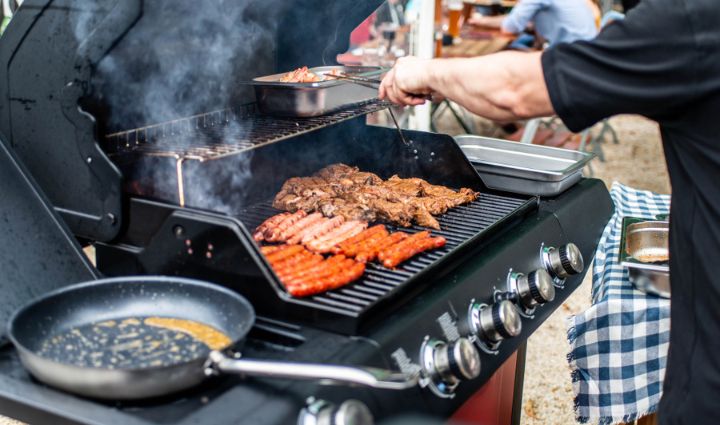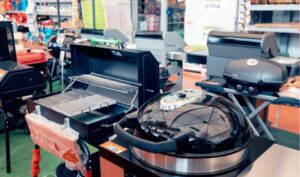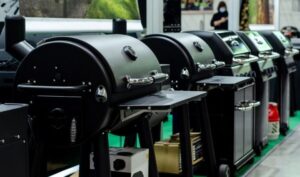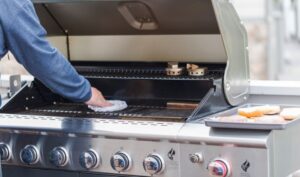This is Part 7 of GrillSpot’s Ultimate Gas Grill Buying Guide, where we’ll cover everything you need to know about how to buy a gas grill, from what factors you need to consider to detailed guides dedicated to everything from budget to grill size to BTUs.
When shopping for the right grill, there are lots of facets to consider—size, shape, features, fuel type, portability—but is anything more important than BTUs? Let’s take a closer look.
BTUs are a measurement of your grill’s firepower, giving you an indication of what you can expect from your barbecue in terms of cooking time and performance.
In this section of the Ultimate Gas Grill Buying Guide we’ll take a closer look at BTUs to answer:
- What are BTUs?
- What are BTU ratings?
- What does BTU mean on a grill?
- What is a good BTU for a gas grill and how many BTUs are needed for grilling?
- Are BTUs actually important?
Now, let’s get cooking.
What Are BTUs?
“BTU” stands for British Thermal Unit, which is a measurement of “how much energy it takes to raise the temperature of one pound (1 LB.) of water by one degree Fahrenheit (1°F).” Not sure how this applies to your barbecue? Keep reading.
What Are BTU Ratings?
Now that you know what “BTU” stands for, you may be wondering “what does BTU mean on a grill?”. BTU ratings indicate how much heat is generated by a burner at its maximum output, and are a rough indicator of how much fuel your barbecue will use in a given period of time.
What Does BTU Mean On A Grill?
Because BTU is a measurement of energy output and fuel usage, a grill with a high BTU rating typically uses more fuel than a grill with a lower rating. Usually, when you see a BTU rating for a grill, the rating will encompass each of the main burners in the grill as a whole to indicate the total heat output of the entire grill per hour. Sometimes, however, a grill’s BTU rating also includes side burners and smoker burners to make it seem more powerful.
What Is a Good BTU for a Gas Grill and How Many BTUs Are Needed for Grilling?
Understanding what BTU stands for and what the ratings mean is all well and good, but you may still be wondering how many BTUs are needed for grilling. Unfortunately, the answer isn’t as simple as “look for a grill that has 40,000 BTUs” because you also have to factor in the size and cooking surface of the grill. To do that, you must figure out how many BTUs per square inch your grill has.
To calculate BTUs per square inch, divide the total number of BTUs by the square inches of the cooking surface:
Total BTUs / Square inches of cooking surface = BTUs per square inch
The best grills offer approximately 110 BTUs per square inch, but—depending on the size as well as several other factors (see the following section)—anywhere from 80 to 100 BTUs per square inch can be more than sufficient for backyard grilling.
Are BTUs Actually Important?
So, are BTUs actually important? Yes, but they are only one piece of the puzzle. It is important to note that a high BTU rating doesn’t automatically mean a grill is better—there are several other factors that come into play when it comes to assessing the power of a barbecue, including:
- Primary cooking surface area: The size of the cooking surface area directly impacts how effective the BTUs are at cooking the food. You need to know the area of the primary cooking surface to properly calculate grill power (see above).
- Materials: The materials the grill and cooking grates are made of affect how the heat behaves within the grill. For example, aluminum heats fast and reflects heat, keeping it inside of the unit, but it also cools quickly. Cast iron grills, on the other hand, get up to temperature more slowly, but once they do, they return the heat and cook your food very evenly. Many foodies prefer cooking with cast iron for this reason.
- Airflow: Airflow may not seem that important, but anyone who has built a fire knows it is integral to better combustion and generating optimal, clean-burning flames. The heat from the burners brings air inside the grill, heating and moving it around, before venting it out the exhaust port. This makes it possible to move the heat generated by those burner BTUs around the grill, efficiently heating everything inside, reducing cold spots and unwanted smoke emissions, and creating more even cooking.
- The ventilation/exhaust port(s): All grills need ventilation or exhaust port(s) to operate, and they are legally required to have them. However, vents that are very large and can’t be adjusted will simply vent all the heat that the BTUs of your grill are generating.
- The size and shape of the grill body or cavity: A grill with a small cavity can use BTUs to heat the grill more quickly. A large cavity will take longer to heat than a small one, but can often make use of airflow, heat retention, and reflectiveness to get up to temperature reasonably fast.
All of these pieces must work together to distribute and use BTUs efficiently. So, as long as the BTU rating is above 80 BTUs per square inch, the rest of these factors will work together to create a grill that performs beautifully, gets up to the right temperature quickly, retains heat, and heats food evenly.
GRILL SPOT TIP: Since BTU is a measurement of power and therefore an indicator of fuel consumption, the higher the BTU is, the more fuel your grill will use to generate that power. If fuel usage is a concern, this can be tempered by selecting a smaller grill or a grill that allows you individual control over its various burners, as well as using appropriate ventilation techniques to maintain good airflow and produce perfect combustion.
Conclusion
BTUs are an important metric to consider when selecting a gas grill. If you’re wondering how many BTUs are needed for grilling, remember that a reasonable BTU rating—between 80 and 110 per square inch of cooking space—is only one part of the necessary ingredients for a grill that will perform and deliver an excellent meal.
Learn more about what to consider when purchasing a gas grill in The Ultimate Gas Grill Buying Guide.





